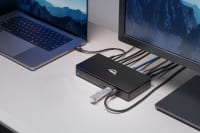What is USB-C?
Though all USB-C and Thunderbolt ports and cables look the same, they are not. Here's what you need to know about these standards and their capabilities.
OWC Newsfeed • May 19, 2022
It’s extremely interesting (frustrating) that we’re still discussing the definition of a technology standard adopted nearly a decade ago, but that’s where we find ourselves with USB-C. With its small size and support for fast charging, fast data transfer, and ability to pipe high quality video/audio, there’s a lot to like about USB-C. You could argue—and many do—that it’s the only port you really need. (Plus it’s just so darn convenient, able to be plugged in any way you like.)
USB-C as a standard was finalized in 2014 and Apple was quick to adopt this “rotationally symmetrical connection type”—as our buddy Jon Hoeg puts it in the video above—when it debuted as the only port period on the short-lived 12-inch MacBook in 2015. And while the majority of modern PCs and Android smartphones and tablets have gradually adopted the connector for charging and data transfer, a couple of things have held society back from single connector bliss: a frustratingly wide swath of drives and other tools sticking with traditional USB-A ports and connectors and—maybe more importantly—Apple’s refusal to replace the Lightning port on the iPhone with USB-C.
Beyond issues with widespread adoption of the port, there’s also the mismanagement of the standard that consumers have had to grapple with. Though they all look the same, USB-C cables can differ wildly in their actual data and charging speeds. Then there’s the Thunderbolt standard which looks like a USB-C port/cable, but is way more powerful. So, Jon is here to help you sort through all of the important decisions and distinctions you may face while you look for the perfect USB-C or Thunderbolt accessory. Check out the video above.
Other topics you might like
OWC Wins Two Best of Show Awards at IBC 2025
Updated on Sep 17, 2025
Three Networks, One Cable: Meet the OWC Thunderbolt 5 Dual 10GbE Network Dock
Updated on Sep 9, 2025
 USA + International
USA + International OWC Canda
OWC Canda OWC Europe
OWC Europe


